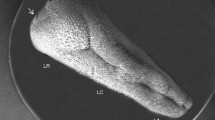Abstract
The nature and morphology of the surface resulting when the pulp is stripped away from the developing dentine was studied in a number of different mammalian species. The surface was examined both by a one-stage carbon replica technique and directly in a scanning electron microscope. In both instances, stereo-pair electron micrographs were prepared by tilting the specimen between exposures. In the case of the replica film, stereo-photogrammetric techniques were applied so that the third dimension could be appreciated and reconstructed. Collagen fibrils were evident at most of the replicated surfaces and appeared always to be orientated parallel with the developing front. Within this orientation, the fibrils formed an extensive network and, especially in manatee predentine, were orientated circumferentially about the odontoblastic tubule openings.
Résumé
La nature et la morphologie de la surface dentinaire, en voie de développement, sont étudiées dans un certain nombre de mammifères, après ablation de la pulpe. Cette surface est examinée à l'aide d'une technique de réplique en carbone et directement sous un microscope électronique “scanning”. Dans les deux cas, des micrographies électroniques stéréoscopiques sont réalisées en inclinant le specimen d'une photo à l'autre. Pour les répliques, des techniques stéréo-photométriques sont appliquées afin d'apprécier et de reconstituer la troisième dimension. Des fibrilles collagènes sont visibles au niveau de la plupart des surfaces étudiées. Ces fibrilles sont toujours orientées parallèlement au front de développement. Les fibrilles constituent un réseau étendu dans le cadre de cette orientation majeure et principalement dans la prédentine du morse, où elles sont orientées circulairement autor des ouvertures des canalicules dentinaires.
Zusammenfassung
Die Eigenschaft und Morphologie der Oberfläche nach Entfernung des Marks vom in der Entwicklung befindlichen Dentin wurde in einer Reihe von verschiedenen Säugetieren untersucht. Die Oberfläche wurde einer einstufigen Kohlereplikatechnik und direkter Raster-Elektronenmikroskopie unterworfen. In beiden Fällen wurden steroekopische Elektronenmikrographien angefertigt, indem die Präparate zwischen zwei Belichtungen geneigt wurden. Beim Replikafilm wurden auch stereogrammetrische Methoden angewandt, um die dritte Dimension sichtbar und rekonstruierbar zu machen. In den meisten replizierten Oberflächen konnten Kollagenfibrillen gesehen werden, die immer parallel zu der sich entwickelnden Front erschienen. Innerhalb dieser Orientierung bildeten die Fibrillen ein ausgedehntes Netzwerk; insbesondere umgaben die Fibrillen in Manateepredentin die Öffnungen der odontoblastischen Kanälchen.
Similar content being viewed by others
References
Bevelander, G.: The development and structure of the fiber system of dentin. Anat. Rec.81, 79–90 (1941).
Boyde, A.: A single-stage carbon replica method for rough surfaces. J roy. micr. Soc. (in press).
Ebner, V. v.: Histologie der Zähne mit Einschluß der Histogenese. In:Scheff's Handbuch der Zahnheikunde. Vienna: Holder 1891.
Frank, R. M.: Données récentes sur l'infrastructure de la dent fournies par les techniques de la microscope électronique. Arch. Stomat. (Liège)7, 127–140 (1952).
—: Ultrastructure of human dentine In: Calcified tissues (ed.H. Fleisch, H. J. J. Blackwood andM. Owen), p. 259–272. Berlin-Heidelberg-New York: Springer 1965.
Gerould, C. H.: Ultramicrostructures of the human tooth as revealed by the electron microscope. J. dent. Res.23, 239–245 (1944).
—: Electron microscope study of the mechanism of fluoride deposition in teeth. J. dent. Res.24, 223–233 (1945).
Hanazawa, K.: A study of the minute structure of dentine, especially of the relation between the dentinal tubules and fibrils. Dent. Cosmos59, 125–148 (I), 271–300 (II) (1917).
Helmcke, J.-G.: Atlas des menschlichen Zahnes im Elektronenmikroskopischen Bild. Berlin-Wilmersdorf: Transmare Photo 1953.
—, u.B. Jahn: Elektronenmikroskopische Untersuchungen über das Dentin im menschlichen Zahn. naturwissenschaften39, 492–493 (1952a).
——: Dentinkanäle des menschlichen Zahns (mit Stereoprojektion). Physik. Verh.3, 120 (1952b).
Johansen, E., andH. F. Parks: Electron-microscopic observations on sound human dentine. Arch. oral. Biol.7, 185–193 (1962).
Kramer, I. R. H.: The distribution of collagen fibrils in the dentine matrix. Brit. dent. J.91, 1–7 (1951).
Martin, D. B. A new mirror stereoscope with optical means of measuring parallax. Int. Soc. of Photogrammetry Commission VII (Photointerpretation) Paris 1966.
Matsumiya, S., andS. Takuma: Atlas of electron micrographs of the human dental tissues. Tokyo: Tokyo Dental College Press 1954.
Noble, H. W., A. F. Carmichael, andD. M. Rankine: Electron microscopy of human developing dentine. Arch. oral Biol.7, 395–399 (1962).
Nylen, M. U., andD. B. Scott: An electron microscopic study of the early stages of dentinogenesis. Publ. Hlth Rep. (Wash.) No 613 (1958).
——: Electron microscopic studies of odontogenesis. J. Indiana dent. Ass.39, 406–421 (1960).
Orban, B.: The development of the dentin. J. Amer. dent. Ass.16, 1547–1586 (1929).
Richards, A. G., andL. Thomassen: Microstructure of tooth surfaces as revealed by the electron microscope. J. Amer. dent. Ass.31, 772–776 (1944).
Rouiller, Ch., L. Hüber etE. Rutishauser: La structure de la dentine. Étude comparée de l'os et l'ivoire au microscope électronique. Acta anat. (Basel)16, 16–28 (1952).
Scott, D. B.: Recent contributions in dental histology by use of the electron microscope. Int. dent. J.4, 64–95 (1953).
—: The electron microscopy of enamel and dentine. Ann. N.Y. Acad. Sci.60, 575–584 (1955).
Shroff, F. R., K. I. Williamson, andW. S. Bertaud: Electron microscopic studies of dentine: the true nature of the dentinal canals. Oral Surg.7, 662–670 (1954).
———, andD. M. Hall: Further electron microscope studies of dentine: the nature of the odontoblastic process. Oral Surg.9, 432–443 (1956).
Symons, N. B. B.: The development of the fibres of the dentine matrix. Brit. dent. J.101, 252–262 (1956).
Walkhoff, O.: Advances in demonstrating the finest details of tissue structure, with espeecial reference to the development of human enamel. Dent. Cosmos65, 160–176 (1923).
Weidenreich, F.: Über den Bau und die Entwicklung des Zahnbeins in der Reihe der Wirbeltiere. Z. Anat. Entwickl.-Gesch.76, 218–260 (1925).
Author information
Authors and Affiliations
Rights and permissions
About this article
Cite this article
Lester, K.S., Boyde, A. Electron microscopy of predentinal surfaces. Calc. Tis Res. 1, 44–54 (1967). https://doi.org/10.1007/BF02008074
Received:
Issue Date:
DOI: https://doi.org/10.1007/BF02008074




